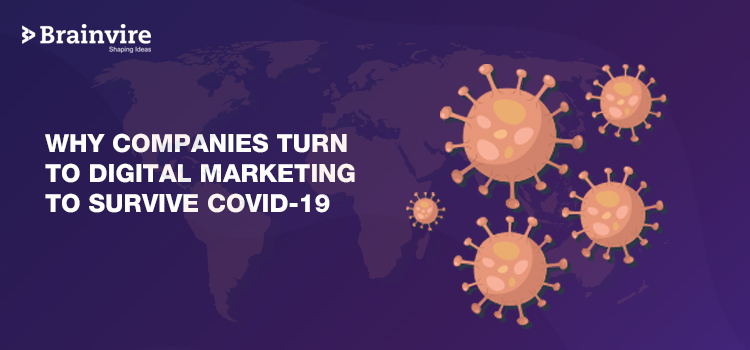
Ecommerce is one of the fastest-growing retail industries in the world, and it’s not going anywhere anytime soon. Nearly a decade ago, anything related to retail was always associated with a physical store. But that was before ecommerce came along.
Over the last decade, ecommerce has completely transformed the way we shop. However, while the ecommerce sector saw exponential growth in 2020, the year 2021 witnessed certain challenges. These challenges included supply chain issues changes in data privacy.
These challenges, it seems, did not hit the breaks on the industry’s expansion. By 2021, the number of online buyers worldwide was expected to reach 2.14 billion.
As we embark on another year slated to experience the aftershocks of a global pandemic situation, how it will pan out for the global ecommerce industry is a concern. Are businesses ready to take on this year? What will help them forge ahead with better strategies and promises of a good ROI?
The internet’s reach has been expansive, and its rapid growth has not gone unnoticed. As a result, it has had a tremendous impact on all businesses—especially the ecommerce industry, with the number of users climbing to new heights.
Consider this forecast to make yourself aware of the impact. By 2023, the number of users globally is expected to rise to a whopping 5.3 billion.
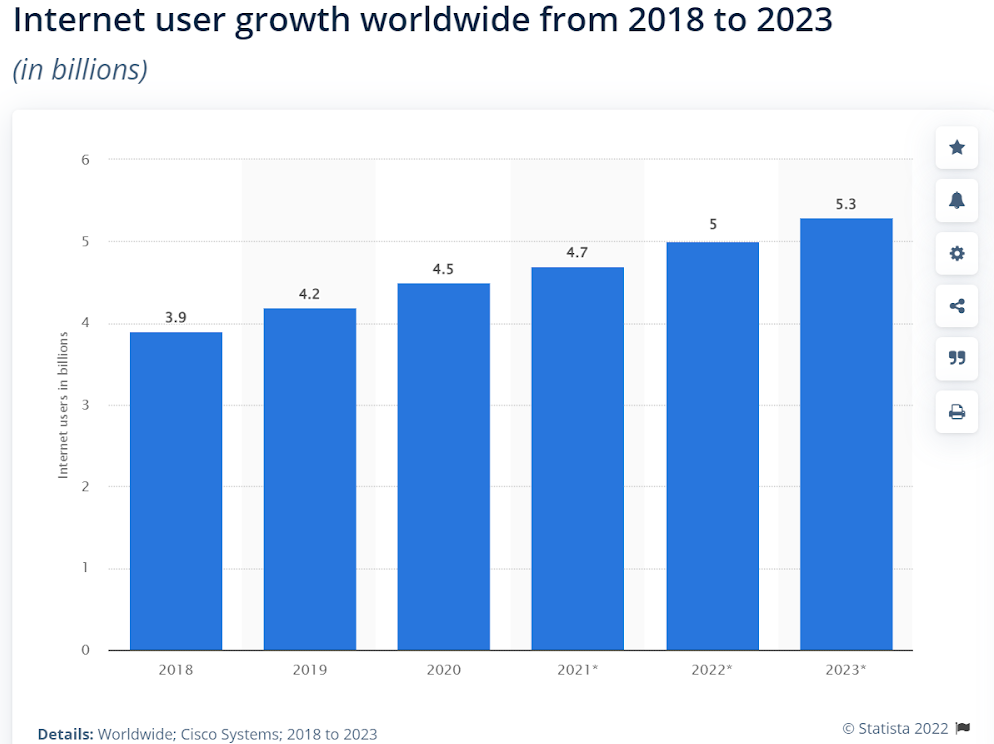
In order to further understand the impact of this on ecommerce sales, consider this. Shopify stores in the U.S. alone saw a 21% increase in their Black Friday sales in 2021. Online shopping festivals have been a huge hit with shoppers worldwide. Many countries, especially China, have seen an increased demand for imported goods bought online.
In fact, Europe and the U.S. stayed ahead with their shopping mega-events such as Black Friday and Cyber Monday. However, one country overtook them by a considerable margin – and that was China.
Looking into it further, another noteworthy trend has emerged. Smartphones are causing a sea-change in people’s lifestyles, from how they communicate to how they shop.
In 2019, smartphone-generated online shopping revenues were the same as desktop devices and also led to 64% of the retail website visits. Further, mobile phones accounted for an average of $84.69 worth of online purchases by September 2020.
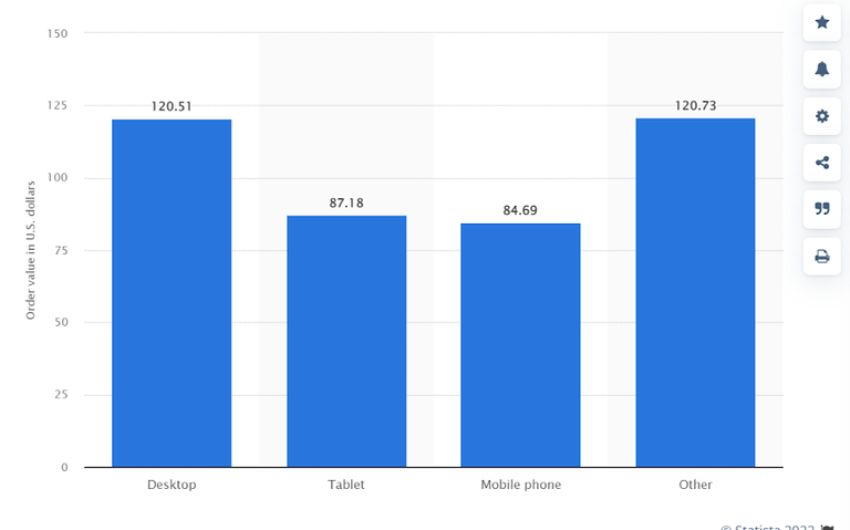
In more recent times, smartphones have become even more popular. As per projections noted in a Statista report, there will likely be 5,575.24 million smartphone users by 2025.
An increasing number of users are relying on smartphones for orders and visits to online stores, or ecommerce sites, as compared to other devices. This is especially true in the case of holiday shopping. Furthermore, social media platforms such as Facebook, Instagram, and YouTube are gaining popularity in this matter as well.
Since ecommerce is such a competitive market, companies have to be creative in order to get their products noticed and ultimately sold. Paid advertising is one way for companies to do this.
Ecommerce advertising is not just about buying ads on the internet. It is a complex process that involves many different components. There are various ways in which it can help your business grow and make you money.
[Also Read: 11 Topmost Ecommerce Trends to Follow in 2021 and How to Include Them in Your Strategy]
Average monthly e-commerce website advertising spending worldwide between January 2019 and April 2020
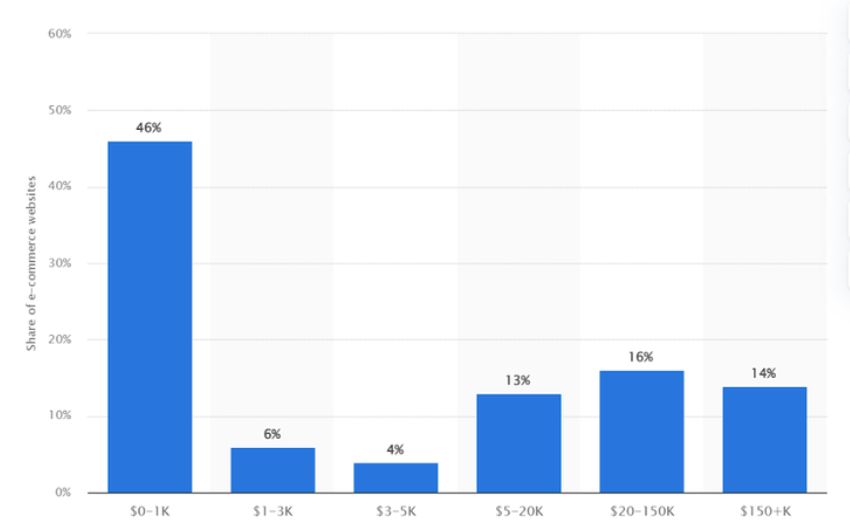
What Is Ecommerce Advertising And Why It Is Important For Your Marketing Strategy?
Ecommerce advertising is a type of advertising that helps ecommerce businesses to sell their products and services. An ecommerce marketing strategy uses ads to increase the number of people who visit their website, find out more about their products and services, and buy them.
The goal of any marketing strategy is to generate revenue for your business. Likewise, the goal of ecommerce advertising is to help your business grow by increasing sales. Ecommerce advertising is an important part of any ecommerce marketing strategy because it helps you generate more revenue by increasing your sales.
Modern-day marketing cannot achieve optimum results without ecommerce advertising. Therefore, optimizing your options with well-planned SEO strategies is an essential part of your marketing strategy. Yet, in order to leverage the maximum potential of digital marketing, ecommerce advertising cannot be ignored.
The benefits of ecommerce advertising cannot be overstated. Together with your SEO efforts, it can help you increase traffic to your website, get higher click-through-rate and, most importantly, conversions! Now, to understand ecommerce marketing better, this article will explore marketing platforms that are most effective in this regard. They are as follows:
- Gmail
- Snapchat
Ecommerce Advertising Tactics to Fully Utilize Your Investment

A good ecommerce marketing strategy is necessary for new ways to market products and services. Paid advertising is one of the most popular ways to promote your product.
There are many tactics that you can use to fully utilize your ecommerce advertising investment and get the best return on your investment, such as:
- Targeting: Targeting is a key component in any marketing strategy. It’s important to know whom you want to reach and what they care about before promoting your product.
- Relevance: Relevance is also an important factor in successful marketing campaigns. You want to make sure that the content you’re sharing relates to your business and what it offers consumers.
- Quality: Quality matters when it comes to paid advertising campaigns because it will keep people
What Are The Different Types Of Paid Media Ads?
Paid advertising is a form of advertising on social media platforms such as Facebook, Google, and Twitter. They are typically more expensive than organic posts, but they have the potential to reach a wider audience than organic posts. Some types of paid ads include:
- Banner Ads: These are displayed at the top of a Ecommerce website or sidebar. They usually link to another page on their site and can be text-only or include an image. Banner ads can be placed by advertisers on any website that allows them (although some sites charge for this service).
- Facebook Ads: These advertisements appear in your newsfeeds or within other parts of Facebook. Facebook Ads make it possible to target specific audiences based on demographics, interests, behaviors, and more.
- Google Ads: They are an excellent way to reach your target audience. The types of media ads available to you through Google Ads include text, image, and video. Text ads can be the most affordable option, while video ads will provide you with the opportunity to tell your company’s story in a captivating format.
How To Manage And Optimize Your Paid Media Campaigns Effectively?

Ecommerce advertising is a type of advertising specifically targeted to the online shopping audience. It can be done via paid advertising on social media, SEO, or other digital channels.
There are many ways to advertise your ecommerce business. The most popular way is paid media advertising, including Google ads and Facebook ads. you can also hire seo services in usa to help drive traffic to your website and social media to increase brand awareness.
Paid Media Advertising: Paid advertising includes Google Adwords and Facebook ads which are the most popular ways for ecommerce businesses to advertise their products or services online. Paid ads are usually directed towards specific target audiences based on demographics, location, interests, and more.
Paid advertising is a great way to increase brand awareness and drive traffic to your site. It is an important part of any marketing campaign as it can drive traffic to your site and increase brand awareness.
Paid advertising is the best way to ensure that your ads are seen by as many people as possible. With its help, you can reach a wider target audience and start building your customer base.
However, SEO can also be used in tandem with other advertising practices to achieve the same goal, which is to increase your online presence. Paid media management is a key part of digital marketing.
In order to be successful, you need to know your target audience and create a strategy that will resonate with them. This article will discuss the best practices in paid media management and how you can optimize your digital marketing campaigns effectively.
Paid media management can be broken down into two categories – Display & Search.
Display media includes primarily digital ads on social media, mobile apps, and websites. These ads are an efficient way to reach potential customers in an organic way.
Search advertising is often referred to as SEM (search engine marketing), which primarily focuses on organic search traffic from Google ads.
For years, search engines have been pivotal in determining the success of many businesses. SEM (search engine marketing) is the practice of optimizing a company’s website to rank higher in organic search results on Google.
SEO is strategically designed to improve the flow of traffic from various sources, including social media platforms and links from other websites.
[Also Read: How to Choose between a Traditional and Innovative Ecommerce Business Model]
As per reports, social media has 3.4 billion users globally, and the expected rise in users will be 4.41 billion in 2025. The most popular platform in India is Instagram, and it has 201.1 million users, with the U.S. noting 157.1 million users and Brazil noting 114.9 million active users.
Further, in the global scenario, Instagram takes the fourth place among popular social media sites, after Facebook, YouTube and WhatsApp.
eCommerce Advertising Using Facebook
Facebook ads are quite effective to get your target audience engaged with your content. They are also one of the most cost-effective ways to market your products or services.
Facebook saw nearly 3 billion users worldwide as of October 2021. In the U.S., Facebook is expected to achieve 76.87 percent penetration by 2026. Here are the statistics on the most popular social networks in terms of active users.
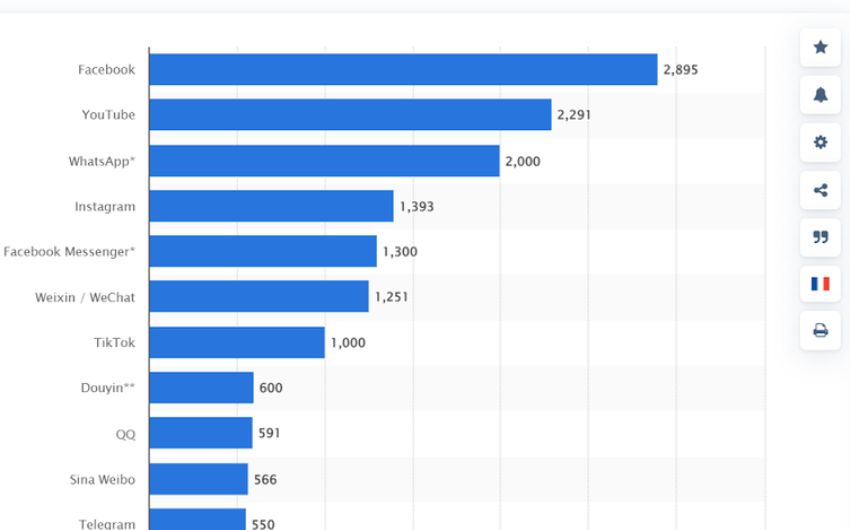
With paid ads on Facebook, you can aim for specific audiences and get them interested in your product or service. Facebook can help you reach people who are not already following you on social media, which is an added advantage.
The key to success is to find the right target audience for your product. You can reach a specific audience by targeting people who match certain criteria using Facebook’s advertising platform. The more specific you are, the more likely you will be successful with your campaign.
There are many different types you can choose from, depending on what you want to promote. Facebook offers tools to make this process more interesting and effective, such as Facebook ads manager and Power Editor.
The different types of Facebook ads include:
– Sponsored or Boosting Posts
– Story Ads
– Lead Ads – Carousel Ads – Video Ads
– Photo Ads
– Canvas Ads
– Instant Experience Ads

With a few clicks, you can schedule a budget, create a campaign with a set of objectives, and choose the type of ad you want to use. You will be able to see your performance in real-time and experiment with it without any risk.
Facebook is extremely popular, with over 2 billion monthly active users. It has become an essential marketing tool for many businesses, especially those that sell products or services online.
In order to target the right people, you need to know who they are and what kind of products they want. There are many ways you can find out about your customers, but Facebook has some of the most robust tools for targeting the right people.
Facebook ads can be directed to any target audience that you want. For example, you can set up custom audiences based on their interests, demographics, or location. Further, you can target people who live in a certain area, people who like certain pages, or even people with certain interests.
This makes Facebook ads great for reaching niche target audiences and getting specific with your targeting. The platform is popular because people are much more likely to buy something when they see it on Facebook.
It also doesn’t cost much to advertise on Facebook, so it’s the perfect platform for small businesses that don’t want to invest a lot of money in ad spending.
eCommerce Advertising Using Instagram
Instagram is a photo-sharing-based social network. It allows users to post and share their images online with friends and followers. In 2018, the number of active Instagram users crossed the 1 billion mark.
In 2020, the U.S. alone saw more than 114 million Instagram users, and by 2023 the number is expected to cross 127 million users. The number of worldwide monthly active users from January 2013 to December 2021 is depicted in this chart.
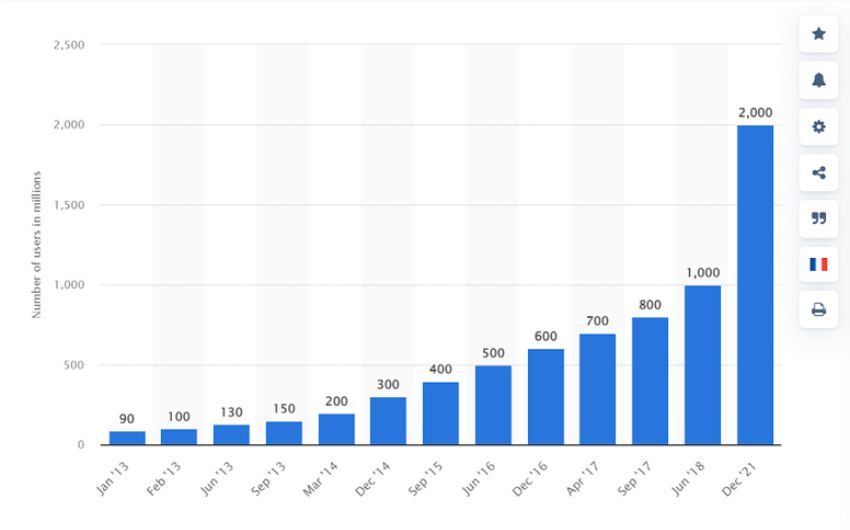
Who Uses Instagram
Audiences on Instagram are predominantly within the younger demographic, of age-group 34 years or below. Statistics also show that Instagram is more popular among teens and has the biggest reach among teens in the U.S.
Celebrity influencers, including athletes and other celebrities, are involved in brand collaborations on Instagram. The social media platform ranks high among marketers with second-highest ROI.
Types of Instagram Ads
Instagram is one of the most popular platforms for people to share their lives with their followers. What makes Instagram different from other social media platforms is that it has a feature called ‘shopping’ which allows users to buy products directly from the app.
This makes it a great place for marketers to advertise their products and services. Types of Instagram ads are varied so that you can display them to your target audience with precision as per suitability.
For example, photo ads are perfect for selling clothing or accessories because they allow you to upload a high-quality image with a caption that is related to the product being advertised. Types of Instagram ads include photo ads, explore ads, shopping ads, collection ads, IGTV ads, and more.
Instagram ads are a powerful tool for the ecommerce marketing strategy of brands to advertise their products. It is a great way of connecting with Instagrammers and getting them to buy your products.
Explore ads are one of the most popular types of Instagram ads. They allow you to showcase your products in an interactive way by letting users swipe through them.
The popularity of Instagram advertising is because they’re targeted towards people who are interested in exploring new products. They’re also the most affordable type of ad on Instagram because they don’t have a set cost per day or per click.
You can also use carousel ads that work similarly but instead show more than one product at a time in the same ad space. Carousel ads are a new feature on Instagram that allows you to show up to 10 images or videos at once in one post.
These types of posts typically get more engagement than other types of posts, so it’s a good idea for advertisers to utilize the new features on the platform.
IGTV is another option for ecommerce brands to advertise their products on Instagram. The difference between IGTV and other types of Instagram ads is that it allows longer videos, so it’s perfect for storytelling or showing how your product works in detail.
Instagram Shopping Ads are different from Instagram ads. They are meant to be more engaging and immersive for the user. In addition, these ads are designed to be more visually appealing than traditional ads.
Users can swipe through the products, zoom in on details, and even shop for items without leaving the app. In addition, shopping ads are available to both small and large businesses, with no minimum ad spend requirement.
The ads can be directed to specific target audiences by gender, age group, country, or language. The shopping ads are also highly interactive – they allow users to click directly on products to shop them in-app or on desktop sites.
[Also Read: 7 Ecommerce Websites for Your Inspiration: Designs Set for Success in 2023]
eCommerce Advertising using Snapchat

As one of the upcoming social media platforms in terms of popularity, Snapchat allows users to share videos and photos. However, these posts are only available for up to 24 hours after they are posted. Popular features of the app include filters that can be used for promotional purposes or just for fun.
It has been a valuable marketing tool for eCommerce sellers because the platform is mainly known for its photo and video sharing features, but it also offers interactive ads with augmented reality, which can be used to promote products or services.
Though popular for years now, it is still not as widely used as Facebook or Instagram. However, there is a potential for Snapchat to become the most popular social media platform in the future.
Snapchat has made a huge impact on the world of social media and advertising. It has been developing new features that make it more appealing to brands and companies.
One of these features is Snapchat’s AR filters that allow users to interact with products and brands in a unique way.
Brands can increase customer engagement by creating unique filters that allow users to virtually try on clothes or glasses, play games, or explore hidden features of the product, all with just one tap.
Another feature of Snapchat is “Commercials,” which are videos broadcasted from brands’ accounts. These commercials are different from other types of ads because they have the potential to be more engaging and personal than traditional ads.
They are created by brands themselves, which means they can be more creative and in line with the brand’s voice. Snapchat’s standard commercial, short videos are 3-6 seconds long. The extended play commercials are 7 to 180 seconds long.
They are usually entertaining and have an interactive component in them. The company also has filters that can be used to promote products or services. A 2020 study found that “both 15-second and 6-second ads are memorable on Snap, but the longer variation holds more value in terms of recall.”
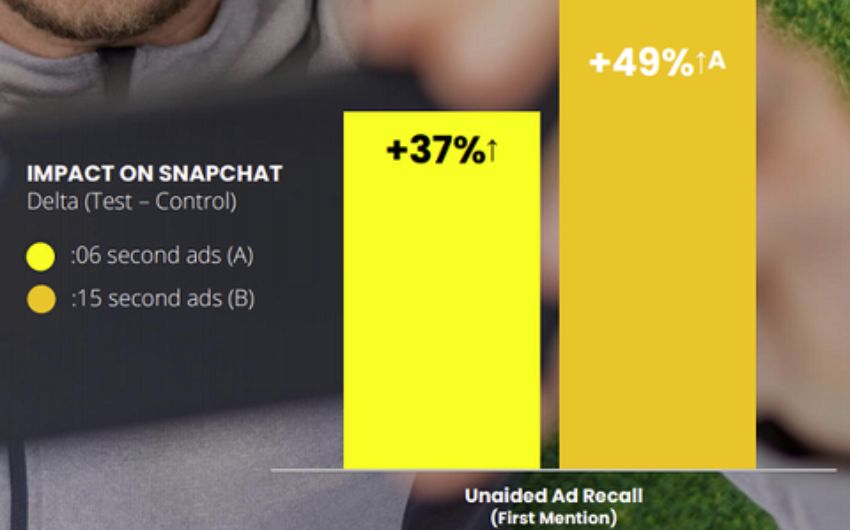
Snapchat has recently been expanding its advertising capabilities by launching interactive ads using augmented reality to create engaging experiences, which users can interact and play with.
The company claims that the new ad format will provide brands with a more immersive experience than traditional ads. It is meant for users to engage in a fun, interactive, and memorable experience.
Snapchat’s daily active user count rose to 97 million in North America and 82 million in Europe during the fourth quarter of 202. As per the latest statistics, the app noted 306 million daily active users worldwide.
The following chart represents the number of daily active Snapchat users from 1st quarter 2014 to 4th quarter 2021, by region.
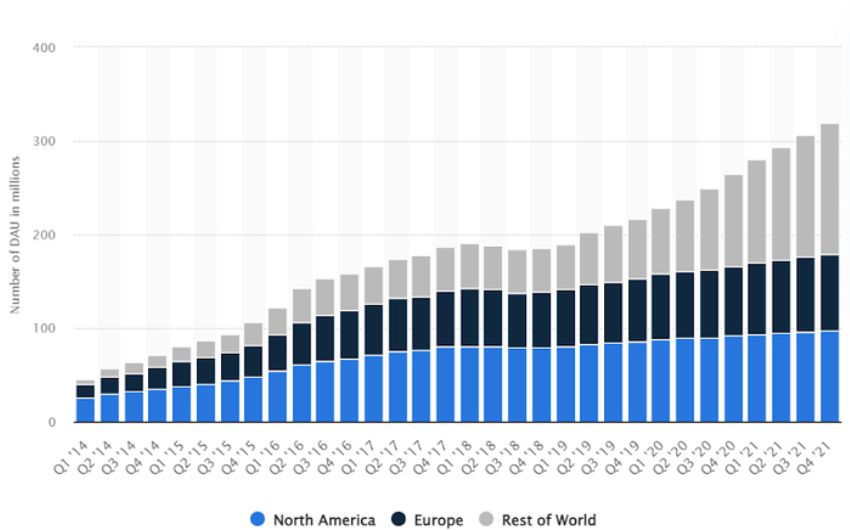
eCommerce Advertising Using Gmail
Gmail ads are interactive and can be placed in the inbox. They offer a more personalized experience to consumers and also allow for a more targeted advertising campaign.
Gmail ads can be targeted to specific audiences. Companies can use the “Promotions” tab in their inbox to send promotional offers or use the “Social” tab to connect with customers.
Gmail ads are also more affordable than traditional advertising platforms because they do not require the same level of expertise for designing ads. Inbox advertisements are an effective way to reach consumers who have opted-in to receive emails from your company.
The Promotions tab of Gmail is a way to reach consumers in a more personalized manner. This tab allows brands to create and manage email campaigns that are interactive and can be sent out at any time.
Gmail ads are interactive, meaning they allow the user to click on a link or an image and be directed to a specific landing page. These ads also have the ability to include videos, images, and links. The “Promotions” tab of Gmail is where these interactive ads can be found.
This is how Gmail ads look in your Inbox:
Furthermore, Google has the ability to run remarketing ads for specific businesses within Gmail campaigns. This allows companies to target their potential customers with relevant ads based on previous interactions with the company.
The different targeting tactics that you can use in Gmail advertising are:
- Demographic Targeting: You can target people who match a certain demographic, such as age and gender.
- Geographical Location: You can target people who live in a certain area.
- Interests and Topics: You can target people who have shown interest in your product or service by including those keywords in your ad copy or ad title.
- Previous Interactions with your Business: You can target people who have interacted with your website before, such as those who visited it, clicked on an ad, made a purchase, or subscribed to a newsletter. Using an insight tool to target your ads, you can reach people who have expressed interest in your product or service. For example, if someone has visited your website before, you could target them with an ad about a new product they may be interested in.
eCommerce Advertising using Google
Google made $209.49 billion in ad revenues in 2021. Google’s advertising revenues come from its Google Ads platform. The platform is meant for advertisers to showcase ads, service offerings, and product listings. These reach users across Google’s extensive ad network of partner sites and apps.
Google’s revenue in 2021 was $256.73 billion, out of which a major contribution came from advertising. Further, search advertising accounts for a significant proportion of Google’s advertising revenue.
It is noteworthy that Google is responsible for a major portion of the online and mobile search market worldwide. As per reports, over 85 percent of desktop search traffic comes from Google as of December 2021.
Here is a graphic representation of Google’s advertising revenue from 2001 to 2021.
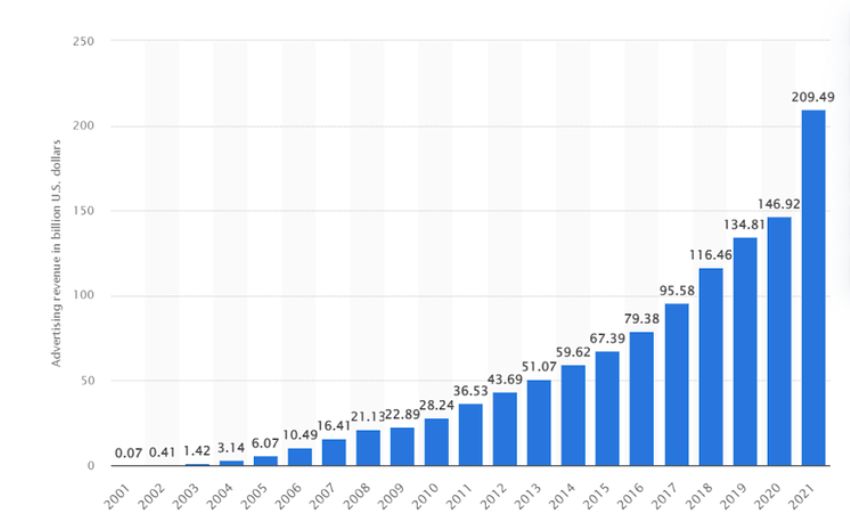
Google Shopping Ads
They are designed to show you ads for items that shoppers are looking for at the moment. Google shopping ads can also help you showcase your products to shoppers who may not be actively looking for your products.
Google Shopping Ads can be used for both online and offline stores, and the ads appear in the form of products that match what you’ve searched for or viewed on Google. The goal of advertising using google shopping ads is to increase the number of people who view your product or service, which will lead to an increase in sales.
Retargeting Ads
Retargeting ads are a form of online advertising that allows advertisers to reach people who have previously visited their website.
Retargeting ads are typically used by eCommerce stores or companies with physical products to show their products to people who already showed interest in them by visiting the site.
Google retargeting ads are an extension of Google Adwords, a service for advertisers to show ads on Google’s network of partner websites and apps. The advertiser’s goal is to make potential customers aware of their product or service and convince them to visit the advertiser’s website, store, or app.
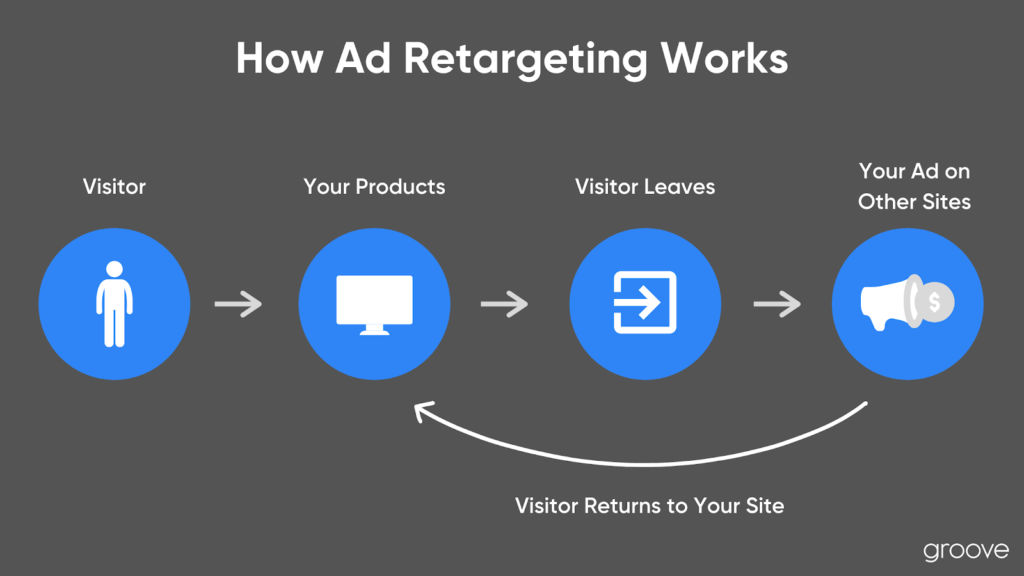
Display Ads
Display ads are typically used for branding and marketing purposes. They are shown on web pages in the GDN rather than on SERPs. Google display ads show a mixture of text and images, which is what makes them so attractive to advertisers.
Google’s Display Network (GDN) is an ad network that helps advertisers reach audiences across a wide range of websites, apps, and YouTube channels for their products or services. Display ads can appear anywhere on the GDN where there is available space for ads.
The visual appeal of display ads is what makes them so popular among eCommerce advertisers. Display ads can be used to highlight products, provide promotions and even show how-to videos.
Display ads are a great way to reach customers with your message and can be used for all sorts of purposes like highlighting products, providing promotions, and showing how-to videos.
In order to be successful, display advertising campaigns should have a well-designed landing page, high click-through rates, and low bounce rates. These metrics indicate that the ad is engaging users and driving them to the desired action.
Paid Media Management Is A Key Part Of Digital Marketing
In order to be successful, you need to know your target audience and create a strategy that will resonate with them. eCommerce Advertising is not just about driving traffic to your website. It’s all about driving sales. This means that instead of focusing on getting visitors to your site, you should focus on getting them to make purchases.
It also means that when you are advertising online, you should be thinking about how best to get people interested in what you are selling. If they are not interested in what you are selling, they will not buy anything from your store no matter how many adverts they see online.
There are many benefits to advertising on ecommerce platforms. The most important of these benefits is that it increases reach, brand awareness, and (most importantly) conversions. You can also use eCommerce advertising to test product ideas before launching them in your own store.
Furthermore, you should be aware of the difference between CPC and CPM advertising models when you are advertising on an ecommerce platform. CPC ads are more expensive, but they also increase your conversion rate by 15%. CPM ads are cheaper, but they don’t have any effect on your conversion rate.
The way you structure advertising campaigns largely depends upon what you want to achieve. This list is an example of campaigns that work across sectors because of the emphasis placed on hyper-targeting. Remember, success can’t be quantified only by clicking on a link. It is the conversion that matters eventually. eCommerce advertising will help drive more valuable traffic to your website and increase conversions.
Related Articles
-
Why Companies Turn To Digital Marketing To Survive COVID-19
During these unprecedented times, when Coronavirus has affected all the nations across the globe, and everybody stuck at home and working remotely, business owners are switching to digital strategies to
-
Brand Communication uplifts business potentials
A company starts to communicate about its existence since its inception. The firm puts conscious efforts to create an identity, and improve brand communication as the brand evolves. A good
-
Boost Your Revenue With Upselling And Cross-Selling
The revenues potential of customers does not end immediately at the point of sale. There are opportunities beyond the initial buy, and cross-selling and upselling practices may help you tap


